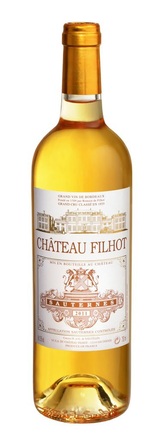
"90 Points - Neal Martin, Vinous.com
The 2009 Filhot shows a little reduction on the nose that I am unable to shake off. Fortunately the palate is better with a viscous opening, moderate weight with marmalade, quince and brown spices towards the composed finish. Whilst not a great Sauternes in the context of the vintage, it is clean and pure and offers plenty of drinking pleasure. Tasted at the vertical tasting at Château Filhot. Drinking Window 2019 - 2035 Reviewed February 2018"
The creation of the vineyard dated from 1630 up to 1650. The chateau was built in 1709 by Romain de Filhot (1641-1710) whose family already owned the noble house ‘Verdoulet’ in Sauternes. At that time, he changed the old label ‘Wine of Langon’ by introducing the Sauternes appellation.
After the revolution, the Lur-Saluces, managed the property, which they had inherited from Josephine de Filhot. In 1840, Romain-Bertrand de Lur-Saluces (1810-1876) joined up the vineyards of Chateau FILHOT and Pineau du Rey. In 1845, he rebuilt the castle in collaboration with the Architect Poitevin. The Landscape Gardener Fisher contributed to the elaboration of the large garden which surrounds the chateau. The vineyard was awarded the ‘Second Cru Classification’ according to the 1855 official classification suggested to Napoleon III by the Negociants and the Chamber of Commerce of Bordeaux. From then on the wine Chateau FILHOT was universally diffused under the name of Chateau Sauternes until the end of the 19th century.
The estate was given back the title of Chateau FILHOT in 1901. In 1935, the Countess Durieu de Lacarelle, born Lur-Saluces, bought the vineyard from her brother. Her son, Louis Durieu de Lacarelle restored and expanded the vineyard until the 1970s. One of the Countess Durieu de Lacarelle’s daughters married the Count Pierre de Vaucelles, ambassador of France. Since 1974, their eldest son, the Count H. de Vaucelles, has been managing the Chateau FILHOT, with his son Gabriel.
Planted Semillon 60%, Sauvignon 36%, Muscadelle 4%